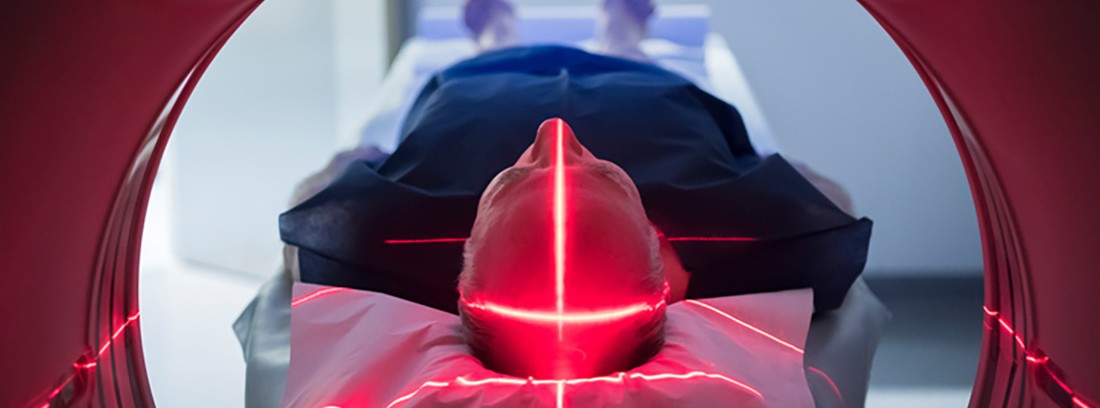Positron emission tomography

The basis of operation of the tomography by positron emission It consists in that after the administration of a specific type of radiopharmaceutical that will have been previously selected according to the tissue that we want to analyze, it will accumulate in greater or lesser concentration on said tissue and will begin to emit positrons that when colliding with each other will give rise to gamma radiation of greater or lesser intensity depending on the amount of radiopharmaceutical accumulated.
The different gamma radiation emitted will be captured by the scanner giving rise to different radiological images that will be sent to a computer for their definition and subsequent study.
Unlike conventional tomography, in which only anatomical images of internal organs are obtained, the positron emission study also allows the study of basic physiological functions such as blood flow, the use of oxygen by the tissues or metabolism sugar (glucose), among others.
This study does not use ionizing radiation (X-rays).
How is the PET positron emission tomography test performed?
The positron emission tomoraphy It is performed in the radiology room of the medical center or hospital by a radiology technician. The patient must undress the anatomical area under study and, if necessary, they will be provided with a gown to cover themselves; at the same time you should remove your personal items, especially jewelry and metal objects that can interfere with radiological images.
Initially, the radiopharmaceutical will be administered, generally intravenously through a vein in the arm or hand; although in some studies it may be administered orally or by inhalation.
The patient must wait in a room for about 60 minutes for the radiopharmaceutical to be fully distributed throughout the body, avoiding speech and movement as far as possible.
Once the radiopharmaceutical has been distributed through the tissues to be studied, the tomographic images will be taken, for which the patient will lie on a stretcher that will move slowly into the scanner (in the form of a tube ). Once inside the scanner, the patient must remain immobile until the end of the study. Inside the scanner the tomographic images of the anatomical area to study and will be sent to a computer for definition and further study.
The duration of the exam will depend on the anatomical area to be studied and the amount of images necessary to complete the study, generally it usually takes 30 minutes.
Preparation for the study.
The Positron emission tomography It does not require prior preparation but the signing of an informed consent by the patient will be requested.
The patient must undress the anatomical area under study and remove their personal items, especially jewelry and metal objects.
The diabetic patient and some specific studies may require some kind of simple preparation such as avoiding the intake of certain foods or sugary liquids hours before the study. The physician or radiology technician should inform the patient of these pre-study conditions.
What does it feel like during and after the study?
Positron emission tomography is painless for the patient except for the discomfort of the administration of the radiopharmaceutical.
The patient must remain immobile while the study is carried out; in some studies you will be asked to take a deep breath and / or hold your breath for better image definition.
Some studies may require the use of a urinary catheter which may be uncomfortable for the patient.
An allergic reaction to the radiopharmaceutical may occur, in the case of presenting a skin rash, or respiratory distress during the study, it should be indicated to the radiology technician immediately
Radiology rooms must be kept at a certain temperature, generally below the temperature of other rooms. Although many scanners are air-conditioned.
Some centers offer open scanners for people who are claustrophobic or severely overweight.
The patient can lead a normal life once the study is finished except for specific indications from the doctor or the technician who has carried out the study.
The radiopharmaceutical is eliminated via the urinary and / or fecal route in the following hours, so proper intimate and hand hygiene is recommended.
Risks of positron emission tomography.
Positron emission tomography does not pose a health risk.
The type of radiopharmaceutical as well as the dose used follows strict safety controls and in general the benefit obtained outweighs the minimal risks of the radiation itself. The amount of radiation emitted by the radiopharmaceutical is minimal and has a half-life of a few hours. The elimination of the radiopharmaceutical is carried out by the kidney and / or fecal route in the course of the next hours or days.
An allergic reaction to the radiopharmaceutical may occur. Severe anaphylactic reaction is rare.
The embryo, fetus, and children are more susceptible to radiation, so in these cases unnecessary studies should be avoided. Women who are pregnant or suspected of being pregnant (including those with an IUD) should avoid the study as much as possible and should tell the radiology technologist that they are pregnant before having a CT scan.
Contraindications to the study
The patient should consult with his doctor before carrying out the study in case of:
- Pregnancy and breastfeeding.
- Kidney or liver failure
- Perform some type of treatment
- Radiopharmaceutical allergy
- Has carried out a similar previous study two months before
What is the study done for?
Positron emission tomography is a relatively simple and safe test, widely used in the field of Medicine as it provides very valuable information for the doctor on anatomical and / or metabolic alterations of the internal organs.
It allows the study and monitoring of multiple conditions such as brain alterations (inflammations, infections, tumor lesions, dementia ...); cardiological alterations (percussion deficit, myocardial ischemia…); tumor and / or metastatic lesions…, among many others.
(Updated at Apr 14 / 2024)